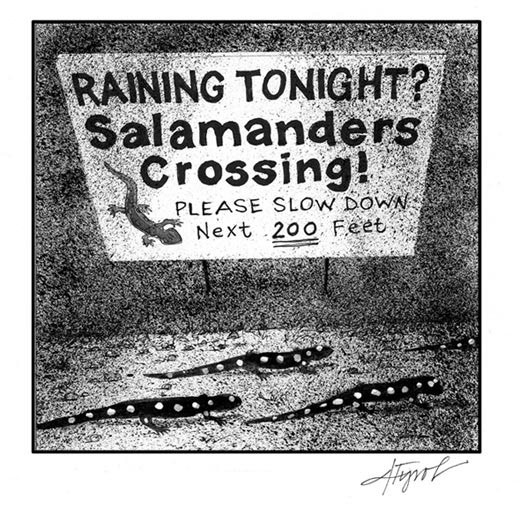
Early April is an unpredictable month in the North Country, a time for back-and-forth tag between the remnants of winter chill and spring warmth. Yet within the unpredictability there is certainty. The earliest flowers poke up, even bloom, right on schedule, in temperatures often well below freezing. The first migratory birds – red-winged blackbirds, robins, woodcocks, killdeers – return to these still-drab, snow-blotched landscapes within a day or two of their usual arrival times. Others, not just birds, will soon follow.
In the next few weeks, even before the snow melts completely, many amphibians will make their annual treks from hibernating locations in the ground or under logs to their ancestral waters and wetlands to breed. Some – wood frogs, spring peepers, and American toads – will sing to claim their territories and attract mates. Others, such as spotted salamanders, are not vocal, but they’re visible—on warm rainy nights they move from their underground winter quarters over land to vernal pools in the forest. They come to pools by the hundreds to breed and leave eggs that will hatch into larvae that will grow into adults.
Later will come butterflies, many of which will sail and skip north to visit summer flowers, then work their way back south as the blossoms disappear. Red admirals and painted ladies, among others, will arrive from as far away as the southern United States, Mexico, Central America and the West Indies. Monarchs will travel north from an isolated 50-acre forest stand in central Mexico, breeding and fanning out as they come, until they occupy milkweed-bearing meadows across the eastern United States and Canada. The last of these northernmost broods will be the ones to re-trace their progenitors’ flight down to Mexico.
Some bats, such as the hoary and silver-haired bats, come north from southern regions, keeping pace with the emergence of flying insects, their source of food; while others, such as the little brown, big brown and Keene’s bat, begin emerging from hibernation in caves and attics throughout the region
Aquatic animals migrate, too. Atlantic salmon, alewives, and American shad swim from the ocean up rivers and streams to spawn in shallow headwaters in the Northeast.
The movement is not all horizontal or latitudinal: crows begin shifting their range in spring from lowlands to higher elevations, while moose go the opposite direction, moving from hills and mountains to wetlands. As the coastal waters of New England warm, lobsters move in from the deep.
These mass movements, repeated twice annually over eons, usually occur along the same routes, and thus become vulnerable to obstacles that humans put in their way. We have a long history of doing so. Hunters in New England, in boats, picked off millions of flightless, helpless great auks as they swam close to shore on 3,000-mile migrations between the Caribbean and the North Atlantic, helping lead to their extinction in 1845. Whalers of generations past pursued their giant quarry worldwide, intercepting them in this region as they moved through the Gulf of Maine on their way between summer’s arctic waters and the winter’s Caribbean breeding and calving grounds – bringing several species to near extinction, all for oil to fuel lamps or lubricate gears.
Dams barred salmon and shad from entry into major New England rivers for spawning, while lake sturgeon, the largest and one of the most ancient of freshwater fish, could no longer swim up tributaries of Lake Champlain to lay eggs. Ocean-side development and recreation on beaches eliminated breeding sites for many migratory shorebirds.
Cars and trucks have squashed untold numbers of crossing amphibians, while millions, perhaps billions, of migrating butterflies end up splashed on windshields and grills. Night-migrating birds hit towers and city skyscrapers in numbers that stagger the imagination (I once picked up 3,000 dead birds, of many species, which had struck guy wires of just three radio towers in a single foggy night during a fall migration.)
Even if the animals survive these perilous journeys, other threats await at destinations. Heavy cutting in tropical and temperate forests has severely reduced the numbers of many migratory birds that depend on both. The small, mountain sanctuary of monarchs in Mexico is under siege from human neighbors who also need forest trees and brush for fuel. Closer to home, vandals have been known to kill roosting bats in caves, including Vermont’s Dorset Bat Cave at Mt. Aeolus, which is considered the largest bat over-wintering site in New England.
On the other hand, we have taken significant strides toward protection. We work to protect migratory bird species, build fish-ways around dams, restrict areas where beach birds nest, and we have placed bars across cave entrances during bat hibernation. We do things that would have been unthinkable a generation ago: In my town volunteers go out with headlamps on rainy spring nights, and with wet hands scoop up salamanders and carry them safely across roads.
Yes, living things are on the move now, and they need our help, in small ways and big, as they try to reach their new homes.

